|
|
Currently showing detailed version of the rules.
Currently showing summary version of the rules.
→ Show summary version
→ Show detailed version
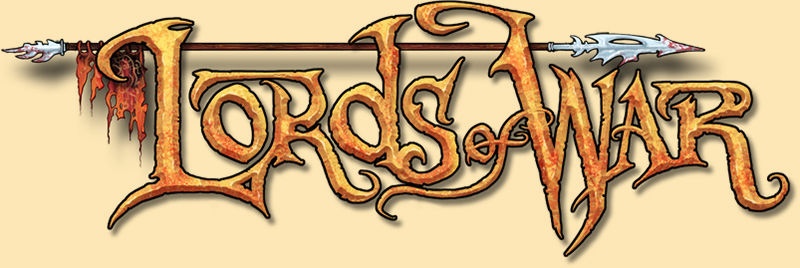
Lords of War
Lords of War is a game of skill, daring and chance - a game of full tactics, betrayal, action and cunning.
Lords of War is more than just a game. It is a community, society, a club. More than that, it is a family. And so, welcome to the Lords of War family - it's ugly, bloody and brutal, and we think you're going to fit in just fine.
Best of luck with your battles - and remember, fortune favors the bold!
Martin Vaux & Nick Street
Black Box Games
The Cards:
The implementation at Yucata.de uses the cards of the
german printed edition. It's possible that the cards of other printed editions differ in background image or attack values.
Each card, also termed as "unit" in these rules, has a number of features as shown in the card diagram below, with the 3 main features being:
- Attack arrows - The direction(s) the unit can attack when it is in play.The unit attacks simultaneously in all the directions its attack arrows point.
- Attack value - The strength of the attack in the given direction.
- Defense value - The strength of the attack(s) the unit can withstand without being eliminated.

Class and Rank:
Each unit has a symbol to denote its class & rank:
Most units can be placed directly into combat on the battlefield. A unit that can engage in combat has one or more attack arrows around its border.
The more attack arrows around a card's border, the more flexible the unit is on where it can be placed and the directions it can attack at the same time.
The higher the number on the card, generally the better the unit is in combat.
A ranged weapon unit with the class symbol  has a target grid and missle damage value on its card as shown: has a target grid and missle damage value on its card as shown:

This type of unit can shoot at enemy units from a distance and are usually best played behind friendly units in order to keep them out of combat and allow effective use of their ranged weapon.
All  spear units and spear units and  ranged weapon units are support units. ranged weapon units are support units.
A support unit does not have to be placed directly into combat, but can be placed adjacent to a friendly unit. Support units can be used to occupy a space on the Battle Mat to prevent an enemy unit from being placed there or placed next to friendly card to prevent an opponent from attacking from a certain direction.
The six Command Cards represent the leaders of the army and are represented by the  rank symbol on their card. rank symbol on their card.
Loss of four of these command units will result in the collapse of the entire army and the immediate loss of the battle. One of the command cards is the army general which is represented by the  rank symbol. rank symbol.
Set-up: The Core Game
- Decide which army each person will play.
- Determine who is player 1 and player 2 by tossing a coin etc.
- Place the Battle Mat face-up with one of the shorter sides in front of each player, so that the number 1 on the Battle Mat is facing and readable by player 1 & the number 2 is facing and readable by player 2.
- Each player takes their General card (with the rank
 symbol on) from their army deck and places it within easy reach. symbol on) from their army deck and places it within easy reach.
- Each player shuffles their army deck with the cards face down and deals the top five cards face down in front of themselves. Each player then places the remainder of the deck face down within easy reach.
- Each player takes the five dealt face down cards and the General card to form their "hand" of six cards. Each player then holds their six cards so only they can see them and should not show them to their opponent.
Winning the game:
The first player to eliminate any 20 of the opposition's cards or 4 of the opposition's Command Cards is the winner.
In the implementation at Yucata.de the game ends at the end of the turn in which a player eliminated the necessary number of Command Cards or cards. Then the player who eliminated the necessary number of Command Cards or cards is the winner.
Rarely, after a suicide move, it may come to the following special cases:
- If both players have the necessary number of Command Cards then the player who eliminated more cards is the winner.
- If both players have the necessary number of cards then the player who eliminated more Command Cards is the winner.
- IF one player has the necessary number of cards while the other has the necessary number of Command Cards then the player with the Command Cards is the winner.
- If both players have the same number of Command Cards and cards then the game is a tie.
Issuing the challenge:
- Player 1 chooses one card from their hand of 6 and places it face up onto the square on the Battle Mat with the number 1 on it. The unit is laid so that it is facing and readable by Player 1, not the opposing player. Player 1 then takes the top card from his army deck (not shoing it to his opponent) to refresh his hand back up to six cards.
- Player 2 then chooses a card from his hand of six and places it face up onto the square on the Battle Mat with the number 2 on it. Player 2 then takes the top card from his army deck (not showing it to his opponent) to refresh his hand back up to six cards.
The battle is ready to begin...
Each player, starting with Player 1, now takes it in turns to follow the 3 Phase Turn Sequence:
Phase 1: Deployment
The player chooses one card from their hand of six and lays it face up onto any empty square on the Battle Mat. The card is laid so that it is facing and readable by the placing player, not the opposing players.
Engagement Rule:
The unit must be placed adjacent to any of the opponent's units on the Battle Mat, so that at least one of its attack arrows is pointing at a corner or edge of at least one of the opposing units on the Battle Mat.
Note
The card you are placing to engage an enemy unit does not have to be adjacent or next to any of your friendly units already on the Battle Mat.
Examples of Deployment: The Dwarf player has a Marauder on the Battle Mat and it is the Orc player's turn. The Orc player chooses to play his Ravager. It must be played according to the Engagement Rule, so it can be placed in any of the following positions:
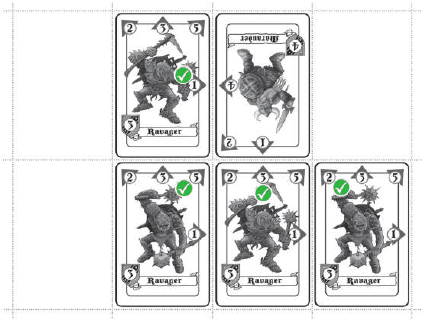
As indicated below, the Orc Ravanger cannot be placed behind the Dwarf Marauder or to the right hand side of it since it will not be following the Engagement Rule as none of its attack arrows would be pointing to a corner or edge of the opposing Dwarf Marauder card.
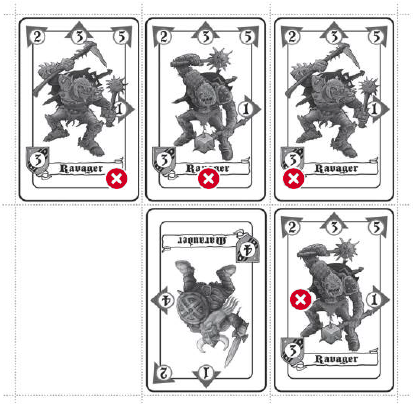
There are two exceptions to the Engagement Rule:
-
The deployment of support units. A support unit (a  spear or spear or  ranged weapon unit) may be played so that it engages in the usual way or instead it can be placed adjacent to any friendly unit on the Battle Mat. When placed adjacent to a friendly unit the card doesn't have to have any of its attack arrows pointing at the friendly unit or have any of the adjacent friendly unit's attack arrows pointing at it. ranged weapon unit) may be played so that it engages in the usual way or instead it can be placed adjacent to any friendly unit on the Battle Mat. When placed adjacent to a friendly unit the card doesn't have to have any of its attack arrows pointing at the friendly unit or have any of the adjacent friendly unit's attack arrows pointing at it.
Note
A support unit gives no + attack or defence bonus of any kind to the friendly unit it is placed adjacent to.
-
If for any reason there are no enemy units on the Battle Mat at the beginning of a player's turn, the player can deploy ANY unit from his hand adjacent to any other friendly unit on the battlefield ("Free Deployment").
If there are no cards on the Battle Mat at the start of a player's turn, the player can place a card from their hand onto any square on the Battle Mat ( special "Free Deployment").
Note
If you cannot lay a card on your turn in accordance to the Engagement Rule and its exceptions, you must place a card of your choosing from your hand adjacent to any enemy card on the Battle Mat and then show your hand to your oppenent (to prove you cannot go).
Phase 2: Elimination
Once the player places a card onto the Battle Mat, they check to determine whether one or more units have been eliminated by combat or ranged attack or a combination of both.
Combat is a simultaneous process and ALL units on the Battle Mat attack in ALL directions of their attack arrows in the same turn. This means no matter whose turn it is all units on the Battle Mat of both players are fighting in combat, which may result in units from either side being eliminated.
Therefore, when a unit is placed onto the battlefield, check the attack and defence value of all the units on the Battle Mat, including ranged weapon attacks, to determine whether a unit has been eliminated.
A unit is eliminated when the total combined attack value of one or more of the opponent's cards engaging and/or "range attacking" the unit, is greater than the unit's defence value.
If the (total combined) attack value is equal or less than the opponent's defence value, then there is no effect and the defending card stays in play on the Battle Mat.
Eliminated units are not removed until the results for all the possible engagements have been checked. An enemy's eliminated units are kept face up in a discard pile to one side of the Battle Mat by the opposing player to keep track of the number of eliminated units needed to win.
Note
Friendly units never cause damage to each other, even if engaging each other.
A one-on-one combat example:
The Orc player has just placed the Orc Deathbringer (OD) to engage the Dwarf Marauder (DM) and Slugger (DS).
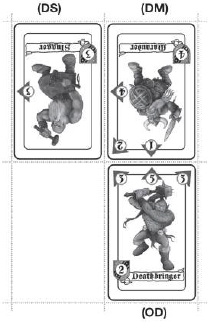
-
The Orc Deathbringer has eliminated the Dwarf Marauder because it is engaging it for an attack value of 5, which is greater than the Marauder's defence value of 4.
-
The Orc Deathbringer has NOT eliminated the Dwarf Slugger because it is engaging it for an attack value of 3, which is NOT greater than the Slugger's defence value of 3.
-
The Orc Deathbringer, with a defence value of 2, has NOT been eliminated by the Dwarf Marauder who is only engaging it for an attack value of 1.
-
The Dwarf Marauder is removed from the Battle Mat and put in the opposing player's discard pile.
A two against one combat example:
The Orc player has just placed the Orc Ravager (OR) to engage the Dwarf Marauder (DM).
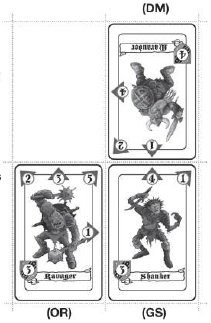
-
The Orc Ravager and Goblin Shanker (GS) have jointly eliminated the Dwarf Marauder. The Goblin Shanker is engaging it for an attack value of 4 and the Orc Ravager is engaging it for an attack value of 5. This combined attack of 9 is greater than the Dwarf Marauder's defence value of 4.
-
The Orc Ravager, with a defence value of 3, has NOT been eliminated by the Dwarf Marauder who is only engaging it for an attack value of 2.
-
The Goblin Shanker, with a defence value of 3, has NOT been eliminated by the Dwarf Marauder who is only engaging it for an attack value of 1.
-
The Dwarf Marauder is removed from the Battle Mat and put in the opposing player's discard pile.
Elimination situations:
Sometimes placing a unit onto the Battle Mat may cause one or more of the following situations, which are all legal moves:
-
the elimination of more than one enemy unit simultaneously, either by itself or in combination with friendly units already on the Battle Mat.
-
the placed unit and any number of enemy units being eliminated at the same time; this is known as suicide move.
-
the placed unit being instantly destroyed and no opposing units being eliminated.
A player that eliminates the enemy's General immediately takes an extra turn, after having refreshed their hand back up to six cards. Killing an enemy General is the only time when the normal turn sequence is disrupted. If both army generals are eliminated simultaneously, neither player gets the option of an extra turn.


Elimination with ranged units
All  ranged weapon units, such as the Orc Catapult (shown) have a target grid with a missle damage value. ranged weapon units, such as the Orc Catapult (shown) have a target grid with a missle damage value.

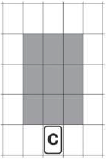
Figure 1
The target grid on the card shows which squares on the Battle Mat the ranged unit can target when deployed. The Orc Catapult, (card C), according to its target grid, can range attack any one of the 9 squares to its front, as represented by the grey squares shown in Figure 1.
The missle value is the damage caused to a chosen single enemy unit every time the ranged unit shoots. The Orc Catapult display above causes 4 points of ranged attack missle damage.
This Dwarf Axethrower is a ranged unit that range attacks to its rear. The Axethrower (card A), according to its target grid, can range attack any one of the 6 squares to its rear when on the Battle Mat, as represented by the grey squares shown in Figure 2.
The Axethrower causes 3 points of ranged attack missle damage.

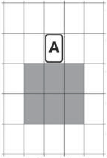
Figure 2
A ranged attack combat example:
The Orc player has just placed the Orc Catapult (OC)(a support unit) adjacent to (behind) his Goblin Shanker (GS).
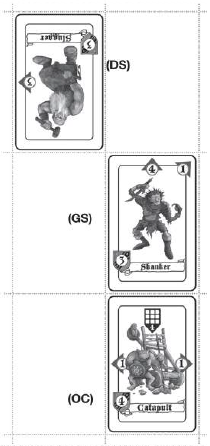
-
The Goblin Shanker is not engaging the Dwarf Slugger (DS), so is not attacking it.
-
The Dwarf Slugger is not engaging the Goblin Shanker, so is not attacking it.
-
The Orc Catapult has eliminated the Dwarf Slugger because it is shooting it for a missle damage value of 4, which is greater than the Slugger's defence value of 3.
-
The Dwarf Slugger is removed from the Battle Mat and put in the opposing player's discard pile.
A combined combat involving a ranged attack example:
The Orc player has just placed the Orc Catapult (OC)(a support unit) adjacent to his Orc Deathbringer (OD).
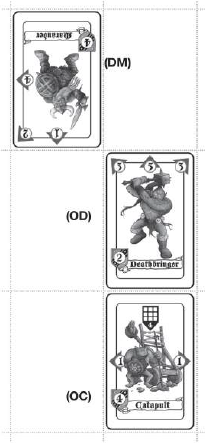
-
The Orc Deathbringer and Orc Catapult have jointly eliminated the Dwarf Marauder (DM). The Orc Deathbringer is engaging it for an attack value of 3 and the Orc Catapult is shooting the Dwarf Marauder for a missle damage value of 4. This combined attack of 7 is greater than the Dwarf Marauder's defence value of 4.
-
The Dwarf Marauder is not engaging the Orc Deathbringer, so is not attacking it.
-
The Dwarf Marauder is removed from the Battle Mat and put in the opposing player's discard pile.
Ranged weapon situations:
Units with ranged weapons can make a ranged attack in the same turn they are placed on the Battle Mat and, once on the Battle Mat, they can make a ranged attack every time it is their controlling player's turn.
 Ranged attack units can shoot over any units and do not need a clear line of sight to the enemy unit they are shooting at. Ranged attack units can shoot over any units and do not need a clear line of sight to the enemy unit they are shooting at.
Ranged units cannot shoot if "engaged" by an enemy unit, e.g. when an adjacent enemy unit has one or more of its attack arrows pointing at it.
Ranged Units who start a turn Engaged CANNOT use their Ranged weapon that turn – even if the enemy unit that was Engaging them is eliminated.
A ranged unit can shoot if it has one or more of its attack arrows pointing at adjacent enemy unit/s (engaging them), but the adjacent enemy units have no attack arrows engaging back.
Units with ranged weapons which find that they have the opportunity to both fire their weapon and fight in combat must choose to do only one during their turn. Ranged weapon units are never permitted to target friendly units.
A ranged weapon unit can only ever shoot at a single enemy unit (chosen by the controlling player) within its target area, but two or more friendly ranged weapon units can shoot at a single enemy unit in a turn.
A Ranged Unit can shoot on the turn it is played onto the battlemat ONLY if it is deployed as a Support Unit (adjacent to a friendly unit) and does not have an enemy card engaging it. This means that a Ranged Unit CANNOT shoot the same turn it is played if it is engaging an enemy unit but it is not adjacent to a friendly unit, as it has not been played as a Support unit.
An enemy unit on the battlemat within the target grid of the ranged unit is NOT "engaged" and can be recalled from the battlemat on the controlling player’s turn according to the normal recall rules.
Ranged Units can only fire at ONE unit within their range during their turn.


Moving Units
A unit that can Move has one or more Movement Arrows:

A Moving Unit can be moved at any time during the controlling player's turn but can only be moved if it is not being engaged by an opposing card. A player does not have to move their Moving Units.
A Moving Unit can only ever be moved one space per turn in the direction of any of its movement arrows, and can only move into an unoccupied space.
Note
A Moving Unit that is deployed from a player's hand onto the Battle Mat can be moved in that turn if it is not engaged. Moving Units that have eliminated an opposing card may still move as long as they have not already moved and are not engaged (which may result in an additional elimination).
Phase 3: Reinforcement
After deploying his chosen unit onto the Battle Mat and determining whether any units have been eliminated or not, the player completes his turn by refreshing his hand back up to six cards.
In order to refresh his hand back up to six cards, a player can choose to either take the top card from his face down army deck and place it into his hand (so only he can see it) or "recall" a unit from the Battle Mat.
To be able to "recall" a unit back from the Battle Mat and into the hand, the unit:
-
must not be engaged by an enemy card (does not have an enemy card adjacent to it that has at least one of its attack arrows directly pointing towards it).
-
must not have been placed down that turn.
-
must not have just taken part in a combat that has eliminated an enemy unit (this includes
 ranged weapon units as well). ranged weapon units as well).
If a unit is not subject to any of the three conditions, it can be withdrawn from the battlefield and placed into the player's hand to refresh the hand back up to six cards.
To the bitter end:
After player 1 has completed his 3 phase turn, player 2 then takes his turn following the three phase turn sequence:
Phase 1 - Deployment
play a unit from your hand onto the battlefield according to the Engagement Rule and its exceptions.
Phase 2 - Elimination
determine whether any unit has been eliminated by combat or ranged attack or a combination of both.
Phase 3 - Reinforcement
increase the number of cards in hand back up to six.
Players continue to take turns following the above three phase turn sequence until one player wins the game.
The implementation of this game at Yucata.de made it necessary to define the 3 Phase Turn Sequence more accurately. To make it also for you 100% clear what happens when, you may check the following Enhanced Turn Sequence Definition:
| 1. |
Pre-Deployment |
Phase |
Player may decides which Shooter is going to shoot where. No elimination is done yet. Units may not move yet.
|
| 2. |
Deployment |
POT* |
The moment the player places a new unit on the board, the system eliminates units based on shot damage defined in Pre-Deployment Phase and current melee damage. This is done simultaneously for all units on the board.
|
| 3. |
Handle Deployment Triggers |
Phase |
The system moves  Berserkers into fields of eliminated units or, if undefined, asks the owner which Berserker to move where. After the Berserkers moved, the system eliminates units based on their current damage which might again move Berserkers. Berserkers into fields of eliminated units or, if undefined, asks the owner which Berserker to move where. After the Berserkers moved, the system eliminates units based on their current damage which might again move Berserkers.
|
| 4. |
Post-Deployment |
Phase |
The player may
- move units. This may lead to units being eliminated and Berserkers being moved.
- shoot with units. The System will check elimination.
|
| 5. |
Reinforcement |
POT* |
The Player takes a card from the battle mat or from his deck. |
*: Point of Time
Tactical Tips
-
Deploy
 ranged units so they are safely shielded from combat behind other friendly units and take advantage of the reach of their weapons. ranged units so they are safely shielded from combat behind other friendly units and take advantage of the reach of their weapons.
-
Do not just play weaker units for the sake of it; they will be eliminated very easily. Deploy a weaker unit to "engage" an opposing stronger unit in one of its vulnerable positions where it does not have an attack arrow. This will stop it from being recalled and make it more vulnerable to elimination.
A weaker unit can also be used to deliver the final attack to eliminate an opposing stronger unit. Even if used in a suicide move; the loss of a weaker unit for the elimination of a stronger unit, such as a command unit, is worth it.
-
The highest attack value is 5. There is not one card in all the decks that has an attack value greater than 5. Knowing than can be useful in your playing decisions.
Intermediate Rules
Intermediate Lords of War matches use all of the base Lords of War rules with some additions. The Intermediate Rules grant new abilities to two unit types:  Cavalry and Cavalry and  Berserkers. Berserkers.
Yucata.de offers a play variant for the basegame that has been described above, as well as for the Intermediate rules for  Cavalry Cavalry and  Berserkers Berserkers that are described in the following. Because the special abilities of these two units enrich the game very much, it is recommended to use basegame variant only as a beginner; it is therefore also deselected per default on the game invitation page.


Infantry Units
Infantry Units in Lords of War are your 'bread and butter' normal Units. They have no inherent special function or 'Unit Effect'.
The key thing to remember is that Infantry Units MUST be played into an attack (i.e. with one or more Attack Arrow pointing at a corner or edge of at least one adjacent Enemy Unit) unless the battlemat is completely empty of enemies, in which situation you can place an infantry unit adjacent to any friendly unit on the battlemat, termed as a "Free Deployment".
If there are no cards from either side on the battlemat you also have a "Free Deployment" and can place an infantry unit on any space on the battlemat.


Berserkers Units
Like  Cavalry, Berserkers function slightly differently in the Intermediate rules. This addition makes Berserkers all the more deadly and more risky to use. Cavalry, Berserkers function slightly differently in the Intermediate rules. This addition makes Berserkers all the more deadly and more risky to use.
Berserker Units are your high risk/high reward Units. Like  Infantry, they MUST be played into an attack (unless a Free Deployment is necessary) BUT Berserkers DO have a special function or 'Unit Effect'. Infantry, they MUST be played into an attack (unless a Free Deployment is necessary) BUT Berserkers DO have a special function or 'Unit Effect'.
When on the battlemat, if your Berserker is part of a combat that eliminates an enemy unit and is not engaged by one or more enemy units, that Berserker MUST move into the space left empty by the eliminated Unit.
Once the Berserker is advanced into the empty space it is determined whether any additional units (and/or the Berserker) are eliminated.
The Berserker only stops advancing if:
-
It is being engaged but not eliminated by an adjacent enemy unit.
-
It does not engage a new enemy unit.
-
It engages an enemy unit with a Shield Value too high for the Berserker to eliminate.
-
It eliminates an enemy card and the Berserker is eliminated in the process.
This can lead to Berserkers achieving multiple Eliminations in one turn and suicide moves where Berserkers eliminate themselves.
If a Berserker is involved in a combat scenario in which 2 or more enemy units are eliminated, the controlling player may choose which empty space to move the Berserker into.
If two or more friendly Berserkers are involved in a combat scenario, the Berserker that has just been deployed that turn is the one that has to be moved into the empty space.
If both Berserkers have been on the battlemat for at least a turn it's the controlling player’s choice on which Berserker to move into the empty space.
After all the Berserkers have been moved then it is determined whether any additional units or the Berserker has been eliminated.
Note
As the Units of the Undead Faction have no blood to get fired-up, they have no Berserkers. A useful fact – could come in handy later!


Cavalry Units
When playing with the Intermediate Rules, Cavalry function slightly differently making them move more fluidly in and out of battle, heightening their usefulness.
Like  Infantry and Infantry and  Berserker Units, Cavalry Units in Lords of War MUST be played into attack (i.e. so that one of their Attack Arrows is pointing to the corner or edge of at least one enemy unit). What makes Cavalry so fun however is that they have a special 'Recall' function. Berserker Units, Cavalry Units in Lords of War MUST be played into attack (i.e. so that one of their Attack Arrows is pointing to the corner or edge of at least one enemy unit). What makes Cavalry so fun however is that they have a special 'Recall' function.
Whereas all other Lords of War Units cannot be recalled if engaged by an enemy Unit during a given turn, Cavalry Units CAN be recalled – so long as they are not Engaged by a  Spear Unit. Spear Unit.
This might seem like a subtle change if you have played Basic Rules Lords of War up until now (and if you are a Dwarf player then you are unlikely to care as you have no Cavalry in your army) but this Unit Effect makes Cavalry a really devastating weapon!
Note
You can even recall your Cavalry unit if, in the same turn, it has taken part in a combat in which an enemy unit was eliminated (This is shown in the below official rule explanation video for Cavalry units).
Note
No card can ever be recalled in the same turn in which it was played.


Spear Units
Spear Units in Lords of War function in a similar way to  Infantry in that they can be deployed to engage an enemy unit. Infantry in that they can be deployed to engage an enemy unit.
Spear Units are also Support Units however (like  Ranged Units) which means that they do NOT have to Engage an enemy Unit when played into battle. Should a player choose to, they can play any friendly Spear Unit adjacent to any other friendly unit. This allows Spear Units to become a building block of a defensive structure or to protect weak points on friendly Units. Ranged Units) which means that they do NOT have to Engage an enemy Unit when played into battle. Should a player choose to, they can play any friendly Spear Unit adjacent to any other friendly unit. This allows Spear Units to become a building block of a defensive structure or to protect weak points on friendly Units.
Additionally, Spear Units are the ONLY type of card which can prevent  Cavalry Units from escaping from battle. If engaged by a Spear, Cavalry CANNOT be recalled into a player’s hand. Cavalry Units from escaping from battle. If engaged by a Spear, Cavalry CANNOT be recalled into a player’s hand.


Ranged Units
Like  Spear Units, Ranged Units in Lords of War CAN be played into an attack directly (i.e. one of their Attack Arrows is pointing to the corner or edge of at least one enemy unit). Also like Spears however, Ranged Units CAN be played adjacent to any friendly Unit on the battlemat. Spear Units, Ranged Units in Lords of War CAN be played into an attack directly (i.e. one of their Attack Arrows is pointing to the corner or edge of at least one enemy unit). Also like Spears however, Ranged Units CAN be played adjacent to any friendly Unit on the battlemat.
There has been some confusion about Ranged Units, what they can do and when they can fire, so let us take a moment to clarify:
-
A Ranged Unit only shoots (if it can), in the controlling player’s turn.
-
A Ranged Unit can shoot on the turn it is played onto the battlemat ONLY if it is deployed as a Support Unit (adjacent to a friendly unit) and does not have an enemy card engaging it. This means that a Ranged Unit CANNOT shoot the same turn it is played if it is engaging an enemy unit but it is not adjacent to a friendly unit, as it has not been played as a Support unit.
-
A Ranged Unit that has the opportunity to both shoot their ranged weapon and fight in combat during their turn must choose to do only one of them.
-
Ranged Units who start a turn Engaged CANNOT use their Ranged weapon that turn – even if the enemy unit that was Engaging them is eliminated.
-
An enemy unit on the battlemat within the target grid of the ranged unit is NOT "engaged" and can be recalled from the battlemat on the controlling player’s turn according to the normal recall rules.
-
Ranged Units can only fire at ONE unit within their range during their turn.
At Yucata.de a  Ranged Unit may not fire at a moving Ranged Unit may not fire at a moving  Berserker. Berserker.
Explanation: It is very unlikely but theoretically possible that during a player's turn a Berserker of his opponent moves over several fields. This may happen if the player makes a suicide move. In this case it's not possible for the player to shoot at this Berserker while it's still moving. A player may only shoot at Berserkers before or after they have moved.
Advanced Rules
In the Advanced Rules of Lords of War rather than keeping their hand secret from one another, the players lay out their hand of cards in front of them at their border side of the Battle Map. This allows the players to see what their opponent can play. This makes the game longer but also more strategic.
Yucata.de offers a play variant for hidden as well as for visible hand cards.
What next?
Battles with no boundaries:
Play the game exactly the same way, but ignore the boundaries of the Battle Mat at all. Playing this way will present new opportunities and challenges to an experienced player.
Yucata.de offers a play variant bordered as well as unbordered that can be selected on the game invitation screen.
Game length:
To shorten or lengthen the game time both players agree to change the number of units and / or command units that have to be eliminated to win.
Beside the normal game length (20 cards or 4 Command Cards needed to win), Yucata.de offers play variants for shorter (15 cards or 3 Command Cards) and longer (25 cards or 5 Command Cards) games.
Personalise your army:
Every core army deck has a number of units of each rank:
 6 Command units 6 Command units 4 Special units 4 Special units 4 Elite units 4 Elite units 6 Veteran units 6 Veteran units 8 Regular units 8 Regular units 8 Recruit units 8 Recruit units
To personalise your army you can take any card out of your army deck and replace it with any card of a similar rank from another deck.
Example: as an Orc player I would like some more ranged firepower, so I take out two Orc Ravagers (of veteran rank) from my army deck and replace them with two Orc catapults (of veteran rank).
Personalising your army by rank swapping in this way can be done with as many cards as you wish.
Designing your own army in this way provides the chance to try a wide range of different combinations to play against your opponents, as well as creating an army that appeals to your own personal style of play.
Building a Mercenary army:
Not happy just playing one race? Using the same rank swapping system, personalise your army even further by taking any card out of your army deck and replacing it with any card of similar rank from any other army deck.
Example: as an Orc player I would like some more archers with a better ranged attack than my Goblin Bow Pests, so I take out two Orc War hogs (of Elite rank) from my army deck and swap them with two Lizardmen Quillshots (of Elite rank).
Yucata Deck Editor
Yucata.de offers you a Deck Editor that allows you to create your own customized decks that you may use in games.
For the players to be allowed to use their customized decks, this must be explicitly selected in the game invitation.
Remark: Be aware when accepting such a game invitation that customized decks can theoretically be stronger than the standard decks!
The allowed deck cards can be restricted via the game invitation screen. For example if you only select Orcs and Elves there then you and your opponent may only use Orcs and Elves in your customized decks accordingly.
The decks you create are persisted permanently. You may use the same deck in further games. You may also adjust it anytime via the Deck Editor. This also means that you need not wait with your deck building until a game starts, but instead you may edit your decks in preparation anytime. Your built deck will be "copied into the game" at the point of time when you select it for a Lords of War game. I.e. the way the deck was built at this point of time it will stay for this game. If you then adjust it while the game still runs, this will have no effect on this game anymore. Only in the next game in which you select this deck again will it be copied with your new adjustments.
Hints on Operating the Game
High Contrast Card Display
Because the numbers on the cards are difficult to read there is a more clearly readable display mode without background image. The following images show the same card in the original and the high contrast mode.
You can select the high contrast mode in-game under the options tab.
The Game Window
- Cards eliminated by the opponent. From left to right:
- Number of eliminated command units
- Number of command units necessary to win
- Number of eliminated non-command units
- Number of non-command units necessary to win
Additionally this information is displayed in graphical form (see D below). When you hover with your mouse over this points display then the eliminated cards will be shown on the battle mat.
- Card deck of your opponent. The number shows the remaining number of cards in the deck. When you hover with your mouse over this deck then the cards will be shown on the battle mat. The same holds true for your own deck.
- Hint: opponent has visible hand cards. This symbol indicates that the opponent has visible cards on his hand. This is helpful if the player information is hidden (see D below).
- Show/hide player information. Click this symbol to show or hide the respective player information. Hiding creates room for the display of cards on the battle mat (good for small screens).
Additionally the button shows the current game points in graphical form. The inner ring shows the number of eliminated command units, the outer ring the number of non-command units. If the ring is entire the respective player has won. Therefore as a warning the rings of the opponent are displayed first yellow and later red.
- Zoom battle mat optimally. Clicking this button scales the battle mat down so it is completely visible.
- Hint: Opponent can see this hand card
- Slide control for zooming the battle mat
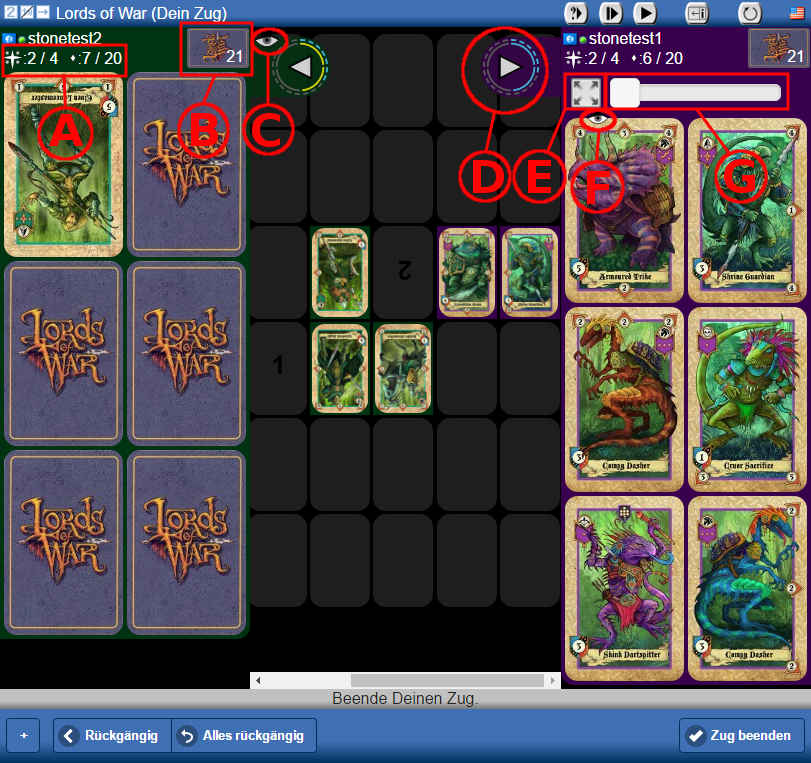
Magnify Cards
The following cases are possible:
-
If a card has no action attached to it then the mouse pointer becomes a magnifying glass when the mouse hovers over the card (see the image below). A click on the card will magnify it then.

-
If actions are linked to the card then a click on the card creates a small popup window in which among others there is the selection to zoom in on the card. See the following image:
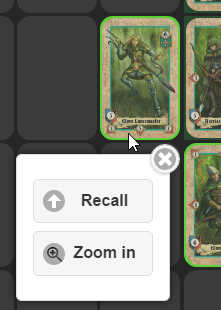
-
For the own hand cards the magnifying works a bit differently. At the beginning of your turn you always need to select the card you want to deploy. The hand cards are therefore (usually) linked to this very action. In order not to always display a popup window with the selection options a) deploy and b) zoom in, the click on the card automatically triggers the action "deploy". This way the player only needs to click once instead of twice for deployment. After the click, that is when the card is selected for deployment, no more actions are linked to the card - the target field for the deployment is an action of the battle mat fields. Therefore it's again case 1 (see above): Another click now magnifies the card directly.
In short: Own hand cards can be magnified by clicking the card twice. Sometimes only one click is sufficient.
| |